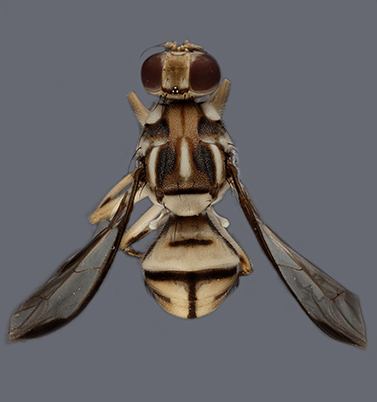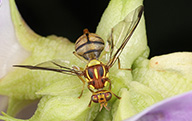Tau Fly
Pest Profile

Left Photo by Severyn Korneyev
Bottom Photo by Fan Gao

The adult tau fly is approximately 7 mm in length (similar to that of a housefly). The body is yellow with black markings. The clear wings have two dark stripes, one along the front margin that ends in a dark spot and one about half as long running diagonal from the wing base. The female has a pointed slender ovipositor to deposit eggs under the skin of host fruit. The egg is almost one millimeter in length, white, cylindrical, and about four times as long as wide. The larva is creamy-white, legless, and may attain a length of nine millimeters. The pupa is encased in a dark brown cylindrical puparium.
History and Economic Importance
Tau fly is an invasive insect originating in Asia. It has a broad host range (see below). Important California crops at risk include cucurbits, avocado, citrus, tomatoes, and peppers. The first California detections occurred in San Bernardino County in 2016, and since that time, 3 re-introductions have been delimited and successfully eradicated.
Distribution
Tau fly is an invasive insect originating in southeast Asia. It is not known to be established in the United States.
Life Cycle
Females lay eggs under the skin of host fruits and a single female can lay more than 400 eggs in her lifetime. The amount of time it takes for egg development depends on the ambient temperature; but eggs typically hatch in one to two days. Larval development is also likely dependent on temperature, but can take as little as one week. The larvae tunnel through the fruit feeding on the pulp, shed their skins twice, and finally emerge through exit holes. The larvae drop from the fruit and burrow into the soil to pupate. In approximately one week, adults emerge from these puparia. The newly emerged adult females need approximately 12 days to mature sexually prior to egg-laying. Breeding is continuous, with several generations per year.
Host and Damage
Tau fly has a broad host range; at least 34 hosts in nine plant families are reported, including melon, okra, peppers, papayas, citrus, cucumber, pumpkin, avocado, tomato, and gourds. It is considered a significant pest of cucurbits. (see Partial Host List below). The adult female lays eggs in host fruit and the larvae tunnel through and feed in this fruit. Fruit that has been attacked may be unfit for consumption due to this damage and as a result of decay-producing organisms that enter, leaving the interior of the fruit a rotten mass.
